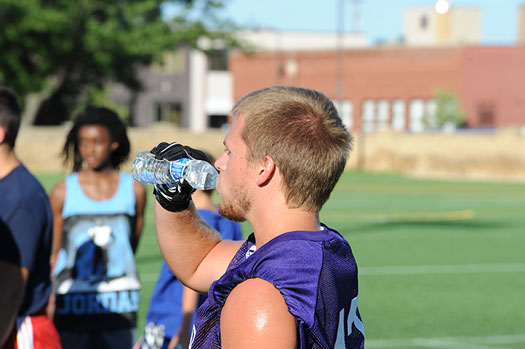May 4, 2020Study: Too many sports drinks can be detrimental
While sports drinks have been touted as a great resource to aid in hydration and replenishing electrolytes in athletes, a recent study suggests that these products can contribute to a dangerous medical condition when temperatures are high.
Athletes ranging from elite distance runners to professional athletes to youth sports participants often turn to sports drinks to maintain a healthy balance of essential minerals. But a study published in the Clinical Journal of Sports Medicine in February 2020 from Stanford University suggests that drinking excess water or sports drinks don’t necessarily help in avoiding hyponatremia — when the body’s sodium levels dip dangerously low — particularly in endurance athletes.
 “There have been recorded fatalities in people who did nothing but drink electrolyte-containing sports drinks,” Grant Lipman, co-author and clinical professor of emergency medicine at Stanford’s School of Medicine, said according to an article published on StraitsTimes.com.
“There have been recorded fatalities in people who did nothing but drink electrolyte-containing sports drinks,” Grant Lipman, co-author and clinical professor of emergency medicine at Stanford’s School of Medicine, said according to an article published on StraitsTimes.com.
He suggests the best way to avoid hyponatremia, and exercise-associated hyponatremia (EAH) in particular, is simply by training better and keeping fit.
“The trick is to trust your body and drink only when you are thirsty. It’s important to realize that sports drinks won’t protect you and might even harm you,” Lipman said in the StraitsTimes article.
To conduct his research, Lipman recruited 266 ultra-marathoners, the majority of whom used electrolyte supplements in-race, from RacingThePlanet’s week-long events, which involved running 240 kilometers in a seven-day period at various places around the world in 2017. Before the race, his team collected blood samples that would be tested for sodium levels and measured each runner’s weight. After the race, they took the same data before the runners rested or rehydrated.
» ALSO SEE: Examining protein in sports drinks
The results showed that 41 runners had salt imbalances after the race, with 11 (6.3%) having developed EAH, and 30 (17.2%) developed hypernatremia. Factors that aided in runners developing EAH included higher temperatures during the race, a shorter training period leading up to the race, higher weight at the outset, taking five to six hours longer than other competitors to finish the race — and over-hydration or consuming too much water or sports drinks.
Lipman noted that one popular sports drink, in particular, has six times less salt than what is found in the blood of a healthy person, so consuming said drink will also water-down salt levels in the blood.
To read the full synopsis of the study from StraitsTimes.com, click here. The study, “Effect of Sodium Supplements and Climate on Dysnatremia During Ultramarathon Running,” appears on the Clinical Journal for Sports Medicine website on February 24, 2020. It can be downloaded for a fee, and the abstract can be viewed for free, by clicking here.



